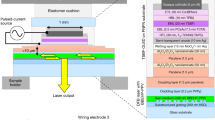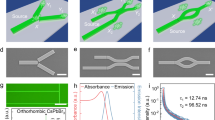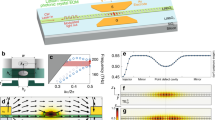Abstract
Modern telecommunications rely on the transmission and manipulation of optical signals. Optical amplification plays a vital part in this technology, as all components in a real telecommunications system produce some loss. The two main issues with present amplifiers, which rely on erbium ions in a glass matrix, are the difficulty in integration onto a single substrate and the need of high pump power densities to produce gain. Here we show a potential organic optical amplifier material that demonstrates population inversion when pumped from above using low-power visible light. This system is integrated into an organic light-emitting diode demonstrating that electrical pumping can be achieved. This opens the possibility of direct electrically driven optical amplifiers and optical circuits. Our results provide an alternative approach to producing low-cost integrated optics that is compatible with existing silicon photonics and a different route to an effective integrated optics technology.
This is a preview of subscription content, access via your institution
Access options
Subscribe to this journal
Receive 12 print issues and online access
$259.00 per year
only $21.58 per issue
Buy this article
- Purchase on Springer Link
- Instant access to full article PDF
Prices may be subject to local taxes which are calculated during checkout




Similar content being viewed by others
References
Mears, R. J., Reekie, L., Jauncey, I. M. & Payne, D. N. Low-noise erbium-doped fiber amplifier at 1.54 μm. Electron. Lett. 23, 1026–1028 (1987).
Slooff, L. H. et al. Optical properties of erbium-doped organic polydentate cage complexes. J. Appl. Phys. 83, 497–503 (1998).
Gillin, W. P. & Curry, R. J. Erbium (III) tris(8-hydroxyquinoline) (ErQ): A potential material for silicon compatible 1.5 μm emitters. Appl. Phys. Lett. 74, 798–799 (1999).
Curry, R. J. & Gillin, W. P. 1.5 μm electroluminescence from erbium (III) tris(8-hydroxyquinoline) (ErQ) based organic light emitting diodes. Appl. Phys. Lett. 75, 1380–1382 (1999).
Hasegawa, Y., Wada, Y. & Yanagida, S. Strategies for the design of luminescent lanthanide (III) complexes and their photonic applications. J. Photochem. Photobiol. C 5, 183–202 (2004).
Winkless, L. et al. Quenching of Er(III) luminescence by ligand C–H vibrations: Implications for the use of erbium complexes in telecommunications. Appl. Phys. Lett. 89, 111115 (2006).
Monguzzi, A. Predictive modelling of the vibrational quenching in emitting lanthanides complexes. Synth. Met. 161, 2693–2699 (2012).
Tan, R. H. C., Motevalli, M., Abrahams, I., Wyatt, P. B. & Gillin, W. P. Quenching of IR luminescence of erbium, neodymium and ytterbium β-diketonate complexes by ligand C–H and C–D bonds. J. Phys. Chem. B 110, 24476–24479 (2006).
Curry, R. J., Gillin, W. P., Knights, A. P. & Gwilliam, R. Silicon-based organic light-emitting diode operating at a wavelength of 1.5 μm. Appl. Phys. Lett. 77, 2271–2273 (2000).
Bradley, J. D. B. & Pollnau, M. Erbium-doped integrated waveguide amplifiers and lasers. Laser Photon. Rev. 5, 368–403 (2011).
Polman, A. & van Veggel, F. C. J. M. Broadband sensitizers for erbium-doped planar optical amplifiers: Review. J. Opt. Soc. Am. B 21, 871–892 (2004).
Han, H-S., Seo, S-Y. & Shin, J. H. Optical gain at 1.54 μm in erbium-doped silicon nanocluster sensitized waveguide. Appl. Phys. Lett. 79, 4568–4570 (2001).
Daldosso, N., Navarro-Urrios, D. & Melchiorri, M. et al. Absorption cross section and signal enhancement in Er-doped Si nanocluster rib-loaded waveguides. Appl. Phys. Lett. 86, 261103 (2005).
Mancino, G. et al. Dramatic increases in the lifetime of the Er3+ ion in a molecular complex using a perfluorinated imidodiphosphinate sensitizing ligand. J. Am. Chem. Soc. 127, 524–525 (2005).
Zheng, Y. X. et al. Near IR luminescent rare earth 3,4,5,6-tetrafluoro-2-nitrophenoxide complexes: Synthesis, X-ray crystallography and spectroscopy. Polyhedron 27, 1503–1510 (2008).
Hernández, I., Tan, R. H. C., Pearson, J. M., Wyatt, P. B. & Gillin, W. P. Nonradiative de-excitation mechanisms in long-lived erbium (III) organic compounds ErxY1−x[(p-CF3-C6F4)2PO2]3 . J. Phys. Chem. B 113, 7474–7481 (2009).
Zhang, J., Shade, C. M., Chengelis, D. A. & Petoud, S. A strategy to protect and sensitize near-infrared luminescent Nd3+ and Yb3+: organic tropolonate ligands for the sensitization of Ln3+-doped NaYF4 nanocrystals. J. Am. Chem. Soc. 129, 14834–14835 (2007).
Mech, A. et al. Sensitized NIR erbium(III) emission in confined geometries: a new strategy for light emitters in telecom applications. J. Am. Chem. Soc. 132, 4574–4576 (2010).
Li, Z. et al. Luminescent zinc(II) complexes of fluorinated benzothiazol-2-yl substituted phenoxide and enolate ligands. Inorg. Chem. 52, 1379–1387 (2013).
Ye, H. Q. et al. Effect of fluorination on the radiative properties of Er3+ organic complexes: An opto-structural correlation study. J. Phys. Chem. C 117, 23970–23975 (2013).
Crosby, G. A., Whan, R. E. & Alire, R. M. Intramolecular energy transfer in rare earth chelates. Role of the triplet state. J. Chem. Phys. 34, 743–748 (1961).
Hernández, I. et al. Efficient sensitized emission in perchlorotropolonate-based Yb(III) complexes. Chem. Commun. 49, 1933–1935 (2013).
Quochi, F. et al. Population saturation in trivalent erbium sensitized by organic molecular antennae. J. Phys.Chem. Lett. 1, 141–144 (2010).
Ern, V., Bouchriha, H., Fourny, J. & Delacôte, G. Triplet exciton-trapped hole interaction in anthracene crystals. Solid State Comm. 9, 1201–1203 (1971).
Pope, M. & Swenberg, C. Electronic Processes in Organic Crystals (Oxford Univ. Press, (1982).
Acknowledgements
H.Y., Z.L. and Y.P. are financially supported by the China Scholarship Council and Queen Mary, University of London. I.H. acknowledges financial support from the Royal Academy of Engineering and the EU FP7 (Marie Curie-CIG-Grant 303535). P.B.W. thanks the EPSRC UK National Mass Spectrometry Facility at Swansea University for help in characterization of Zn(F-BTZ)2 and its precursors. Y.Z. acknowledges financial support from the Major State Basic Research Development Program (2013CB922101, 2011CB808704) and NSFC (21371093). W.P.G. acknowledges financial support from EPSRC (EP/K004484/1).
Author information
Authors and Affiliations
Contributions
H.Y. prepared samples, collected data and modelled the waveguides. Z.L., Y.P., Y.X.Z., Y.X., C.C.W. and T.Y.L. synthesized and characterized the materials. H.Y., A.S. and G.A. helped with the waveguide fabrication. Z.L. produced and characterized the OLEDs. P.B.W. directed the chemical synthesis programme. I.H. contributed to the strategy and directed the experiments. W.P.G. designed the study and wrote the paper. All authors discussed the results and commented on the manuscript.
Corresponding authors
Ethics declarations
Competing interests
The authors declare no competing financial interests.
Supplementary information
Supplementary Information
Supplementary Information (PDF 1002 kb)
Rights and permissions
About this article
Cite this article
Ye, H., Li, Z., Peng, Y. et al. Organo-erbium systems for optical amplification at telecommunications wavelengths. Nature Mater 13, 382–386 (2014). https://doi.org/10.1038/nmat3910
Received:
Accepted:
Published:
Issue Date:
DOI: https://doi.org/10.1038/nmat3910
This article is cited by
-
Research on the mechanical and electromagnetic properties of white Portland cement paste containing basalt fiber
Archives of Civil and Mechanical Engineering (2023)
-
A hybrid erbium(III)–bacteriochlorin near-infrared probe for multiplexed biomedical imaging
Nature Materials (2021)
-
Enhanced 1.54-μm photo- and electroluminescence based on a perfluorinated Er(III) complex utilizing an iridium(III) complex as a sensitizer
Light: Science & Applications (2020)
-
Impressive near-infrared brightness and singlet oxygen generation from strategic lanthanide–porphyrin double-decker complexes in aqueous solution
Light: Science & Applications (2019)
-
High sensitization efficiency and energy transfer routes for population inversion at low pump intensity in Er organic complexes for IR amplification
Scientific Reports (2018)



